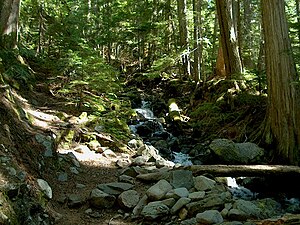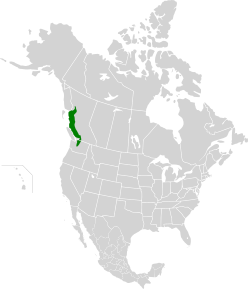British Columbia Mainland Coastal Forests ecoregion
| British Columbia Mainland Coastal Forests | |
|---|---|

Forest on Mount Garibaldi
|
|
 |
|
| Ecology | |
| Biome | Temperate coniferous forests |
| Bird species | 221 |
| Mammal species | 78 |
| Geography | |
| Area | 120,500 km2 |
| Countries | United States and Canada |
| Conservation | |
| Habitat loss | 0.4161% |
| Protected | 17.38% |
British Columbia mainland coastal forests is a temperate coniferous forest ecoregion the Pacific coast of North America, as defined by the World Wildlife Fund (WWF) categorization system.
The WWF defines the ecoregion as the mainland coast of British Columbia up to 150 km inland to the crest of the Coast Mountains, extending along the western front of the northern Cascade Range in northwestern Washington. Specific areas include the Pacific and Kitimat Ranges of the Coast Mountains, the Nass Ranges and the basin of the Nass River. An exclave of the ecoregion occupies the eastern slope of the Olympic Mountains on Washington's Olympic Peninsula. The landscape is a mixture of coastal lowland with many steep valleys, inlets, and fjords. The climate is drier on the inland mountains than right on the coast and the average annual temperature in the valleys is 6.5 °C.
There are three distinct types of vegetation on this coast: the forests of the coastal plain dominated by western hemlock (Tsuga heterophylla), western red cedar (Thuja plicata) and amabilis fir (Abies amabilis); mountain forest of mountain hemlock (Tsuga mertensiana), amabilis fir and yellow cedar (Chamaecyparis nootkatensis); and alpine tundra with sedge (Carex) meadows and lichen-covered rocks.
...
Wikipedia
